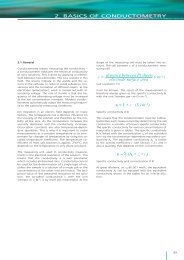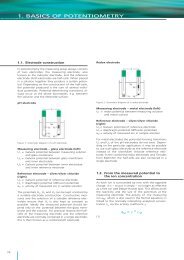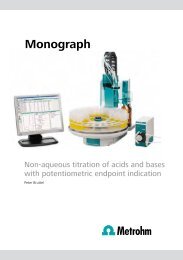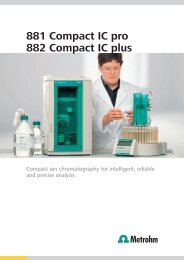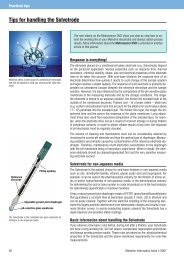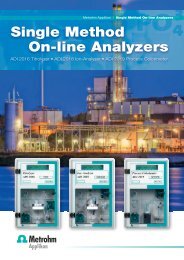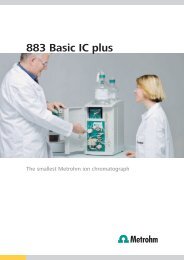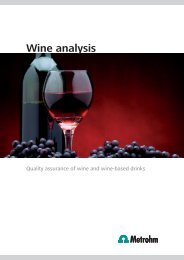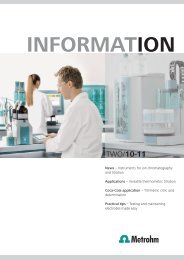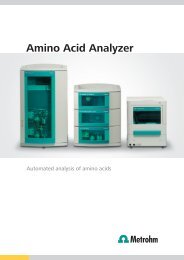Surface Plasmon Resonance with the Autolab SPR ... - Metrohm
Surface Plasmon Resonance with the Autolab SPR ... - Metrohm
Surface Plasmon Resonance with the Autolab SPR ... - Metrohm
- No tags were found...
You also want an ePaper? Increase the reach of your titles
YUMPU automatically turns print PDFs into web optimized ePapers that Google loves.
AUTOLAB APPLICATION NOTE<strong>Surface</strong> <strong>Plasmon</strong> <strong>Resonance</strong> <strong>with</strong><strong>the</strong> <strong>Autolab</strong> <strong>SPR</strong> instrumentsIntroduction<strong>Surface</strong> <strong>Plasmon</strong> <strong>Resonance</strong> is a surfacesensitive optical technique that can be used tostudy nano thin (organic) layers on noble metalfilms. The technique is based on measuring <strong>the</strong>change in refractive index due to, for examplebinding of an organic layer on a metal surface.TheoryThe surface plasmon resonance effect is basedon <strong>the</strong> interaction between electromagneticwaves of incident light and free electrons in aconducting surface layer. When light is reflectedat <strong>the</strong> interface of two dielectric media, totalinternal reflection will take place above <strong>the</strong> socalledcritical angle. At <strong>the</strong> same time, <strong>the</strong> lightwill generate an evanescent field. Thiselectromagnetic field has maximum intensity at<strong>the</strong> surface of <strong>the</strong> dielectricum. In case a metallayer is present in <strong>the</strong> evanescent field, <strong>the</strong> fieldcan be enhanced and <strong>the</strong> free electrons on <strong>the</strong>outer surface (also called: surface plasmons)can resonate <strong>with</strong> <strong>the</strong> field. This is called surfaceplasmon resonance. In cases where thisresonance effect takes place, light will betransferred to surface plasmon waves and onewill thus see a decrease in <strong>the</strong> amount ofreflected light. The angle at which this decreaseoccurs is called <strong>the</strong> resonance angle, see figure1. Because <strong>the</strong> wave vector of light in air isalways smaller than <strong>the</strong> wave vector in <strong>the</strong> noblemetal surface, aFigure 1: Schematic view of <strong>SPR</strong> principle.laser beamsampleϕ <strong>SPR</strong>evanescent fieldgold layerdetectorglassimmersion oilhemi-cylindrical lensangleBare gold disk“dip”prism is needed between <strong>the</strong> sample and air tomake sure that <strong>the</strong> wave vectors in both mediacan be <strong>the</strong> same. The <strong>SPR</strong> effect is usefulbecause any change in <strong>the</strong> dielectric constant(or <strong>the</strong> refractive index) will result in a change in<strong>the</strong> resonance angle.MethodsThere are a few different ways to measure <strong>the</strong>resonance angle. Most well known are <strong>the</strong>methods:1. Used by Biacore in which a convergent lightbeam is used. This beam results in a number ofincidence and reflecting angles. The resonanceangle <strong>the</strong>n shows up on <strong>the</strong> detecting photodiodeas a dark spot. Advantage of this methodis that no mechanical parts are needed to control<strong>the</strong> angle of incidence. Disadvantage is that <strong>the</strong>resolution in refractive index is usually onlyaround 10 -3 .2. Used in <strong>the</strong> <strong>Autolab</strong> <strong>SPR</strong> instrument (seefigure 2) in which <strong>the</strong> reflection is measured as afunction of <strong>the</strong> incident angle of <strong>the</strong> light beam.The incident angle is changed by using avibrating mirror. The advantage of this system isthat <strong>with</strong>in a short time a broad range of incidentangle can be measured. In <strong>the</strong> vibrating mirrorset-up, <strong>the</strong> angular shift is measured for a noncoatedgold sensor surface <strong>with</strong> a resolution ofapproximately 0.05 millidegrees, correspondingto a refractive index resolution of approximately1*10 -6 . For a coated gold sensor surface, <strong>the</strong>angular shift is measured <strong>with</strong> a resolution ofapproximately 0.1 millidegrees.APPLICATION NOTE 10 AUTOLAB INSTRUMENTS ARE DEVELOPED AND PRODUCED BY METROHM AUTOLAB B.V. IN THE NETHERLANDS WWW.METROHM-AUTOLAB.COM
AUTOLAB APPLICATION NOTE3. Where instead of changing <strong>the</strong> angle ofincidence, <strong>the</strong> wavelength of <strong>the</strong> light ischanged. This method is used in an optical fibresetup.The <strong>SPR</strong> effect is only available on metals inwhich <strong>the</strong> electrons behave as a free electrongas, meaning that <strong>the</strong>ir motions are independentof <strong>the</strong> charge that <strong>the</strong>y leave behind whenmoving. This limits <strong>the</strong> choice of metal to copper,silver, aluminium and gold.Figure 2: <strong>Autolab</strong> <strong>SPR</strong> optical principle.Gold is by far <strong>the</strong> most used in biologicalapplications. The thickness of <strong>the</strong> metal layerdepends very much on <strong>the</strong> optical constants of<strong>the</strong> bulk material as well as on <strong>the</strong> wavelength of<strong>the</strong> light. The <strong>Autolab</strong> <strong>SPR</strong> instrument uses 670nm as a wavelength resulting in an optimumthickness for <strong>the</strong> gold layer of about 50 nm.There is a linear relationship between <strong>the</strong> amountof bound material and shift in <strong>SPR</strong> angle. The<strong>SPR</strong> angle shift in millidegrees is used as aresponse unit to quantify <strong>the</strong> binding ofmacromolecules to <strong>the</strong> sensor surface. Theresponse also depends on <strong>the</strong> refractive index of<strong>the</strong> bulk solution. A change of 120 millidegreesrepresents a change in surface protein ofapproximately 1ng/mm2, or in bulk refractiveindex of approximately 10 -3 .The detection principle limits <strong>the</strong> size of <strong>the</strong>analyte that can be studied. If <strong>the</strong> molecularweight of <strong>the</strong> compound is below 5000 Dalton,<strong>the</strong>n <strong>the</strong> change in refractive index upon bindingto <strong>the</strong> sensor surface is too low to be detecteddirectly. Only special modified layers incombination <strong>with</strong> specific small molecules willshow <strong>the</strong> direct binding. The penetration depth of<strong>the</strong> evanescent wave of 300-400 nm alsodetermines <strong>the</strong> size of macromolecules orparticles that can be studied. Particles largerthan 400 nm cannot be measured totally. As aresult, <strong>the</strong> signal is not linear related to <strong>the</strong>amount of bound particles. Under <strong>the</strong>secircumstances it is possible to study <strong>the</strong> bindingqualitatively, but a quantitative or kinetic analysiscannot be performed.ApplicationsSince <strong>the</strong> <strong>SPR</strong> effect is only sensible to changesthat take place in a few hundred nm from <strong>the</strong>surface most of <strong>the</strong> studies involve adsorbedmolecules, meaning that in cases where forexample antibody-antigen interactions arestudied, one of <strong>the</strong>m will be immobilized on <strong>the</strong>surface. With <strong>the</strong> <strong>SPR</strong> disc that comes <strong>with</strong> <strong>the</strong><strong>Autolab</strong> <strong>SPR</strong> instrument <strong>the</strong> following options arepossible:Bare gold surfaces:Macromolecular interaction measurements canbe performed by coating <strong>the</strong> ligandelectrostatically to <strong>the</strong> surface, followed byadding <strong>the</strong> analyte. After coating, a blockingcompound is usually necessary to preventaspecific interactions. This method is especiallysuitable for detection of large particles as cellsand viruses.Biomolecular interaction measurements <strong>with</strong>biotinylated macromolecules. Firstly, <strong>the</strong> goldsensor surface is coated <strong>with</strong> biotin, followed bybinding <strong>with</strong> streptavidin. Secondly, biotinylatedmolecules are allowed to bind <strong>with</strong> unoccupiedbinding sites of streptavidin (stoichiometrystreptavidin-biotin interaction is 1:4). Thirdly,binding of <strong>the</strong> analyte can be measured.Biomolecular interaction measurements <strong>with</strong> thiolcontaining compounds. Gold shows a stronginteraction <strong>with</strong> sulphur. By applying thisproperty for peptides, self-assembled receptorlayers are developed.Direct measurement of low molecular weightcompounds by response enhancement <strong>with</strong> latexparticles. Low molecular weight compounds canbe attached to carboxy modified latex by acarbodiimide coupling reaction Direct binding oflow molecular weight compounds coupled tolatex particles can be determined using a coatedligand at <strong>the</strong> sensor surface.Measurements on conducting polymers usingelectropolymerization.APPLICATION NOTE 10 AUTOLAB INSTRUMENTS ARE DEVELOPED AND PRODUCED BY METROHM AUTOLAB B.V. IN THE NETHERLANDS WWW.METROHM-AUTOLAB.COM
AUTOLAB APPLICATION NOTEAno<strong>the</strong>r option is <strong>the</strong> use of a so-called sensorchip(Pharmacia AB, Sweden) which is a wafercovered <strong>with</strong> a dextran coated gold-layer. Thedextran coating is very suitable to studymacromolecular interactions. Three methods areused to couple ligands:Immobilization of <strong>the</strong> ligand. The ligand iscoupled covalent ei<strong>the</strong>r by amine functionalgroups or by thiol functional groups to <strong>the</strong>dextran layer.Non-covalent binding of biotinylated ligand to astreptavidin-immobilized sensor chip. Due to <strong>the</strong>severe biotin-streptavidin interaction, it ispossible to regenerate <strong>the</strong> surface <strong>with</strong>outbreaking <strong>the</strong> non-covalent biotinstreptavidinbond. This method is suitable to couple syn<strong>the</strong>ticDNA molecules to <strong>the</strong> surface.Immobilization of capturing antibodies. Capturingantibodies are used when <strong>the</strong> activity ofantibodies is reduced by <strong>the</strong> immobilizationprocedure. Detection of antigens is achieved inthree steps. Firstly, immobilization of <strong>the</strong>capturing antibody (for example anti-Rabbit AntiMouse-Fc). Secondly, binding of <strong>the</strong> secondantibody (a mouse antibody) by <strong>the</strong> capturingantibody. Thirdly, specific binding of <strong>the</strong> antigenby <strong>the</strong> second antibody. Regeneration of <strong>the</strong>surface will usually break all non-covalentinteractions.These methods have been used to studybiomolecular interactions intensively. Examplesof biomolecular interactions are:peptide-antibody interactionprotein-antibody interaction, epitope mappingprotein-DNA interactionprotein-polysaccharide interactionprotein-virus interactionprotein-cell interactionprotein-T cell receptor interactionantibody-antibody interaction, capturing antibodyDNA-DNA interactionElectrochemical <strong>Surface</strong> <strong>Plasmon</strong> <strong>Resonance</strong>(E<strong>SPR</strong>)Through <strong>the</strong> combination <strong>with</strong> an <strong>Autolab</strong>Potentiostat, <strong>the</strong> <strong>Autolab</strong> <strong>SPR</strong> instrument is verywell suited for E<strong>SPR</strong> experiments, where <strong>SPR</strong>phenomena are studied in-situ during anelectrochemical experiment. This combination oftechniques has been described by a number ofdifferent groups for example to study <strong>the</strong>changes in a thin organic film upon change of<strong>the</strong> electrostatic field (or potential of <strong>the</strong>electrode). This technique is thus well suited forbiosensor development, <strong>the</strong> development ofmodified electrodes, electropolymerization, etc.Experimental exampleIn <strong>the</strong> figure below a cyclic voltammogram isshown of toluidine blue in 0.1 M KCl solution. Theexperiment was performed in <strong>the</strong> cuvet of an<strong>Autolab</strong> <strong>SPR</strong> instrument, where <strong>the</strong> gold layer of<strong>the</strong> glass was used as working electrode. A Ptwire was used as counter electrode and aminiature Ag/AgCl electrode as a reference. Thechange in <strong>the</strong> <strong>SPR</strong> resonance angle (or <strong>the</strong>refractive index) indicating <strong>the</strong> adsorption of <strong>the</strong>Toluidine molecule in <strong>the</strong> oxidized state is shownin <strong>the</strong> blue curve. It is clearly visible that uponoxidation of <strong>the</strong> toluidine molecule adsorption on<strong>the</strong> surface takes place (positive change in <strong>SPR</strong>angle). In <strong>the</strong> reduced state, <strong>the</strong> toluidinemolecule is back in solution again.APPLICATION NOTE 10 AUTOLAB INSTRUMENTS ARE DEVELOPED AND PRODUCED BY METROHM AUTOLAB B.V. IN THE NETHERLANDS WWW.METROHM-AUTOLAB.COM




